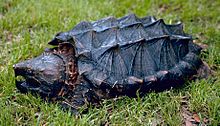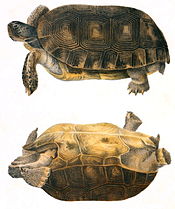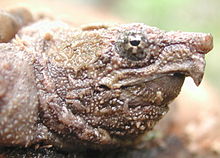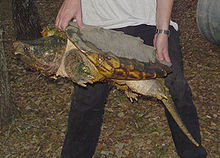- Alligator snapping turtle
-
Alligator snapping turtle 
Conservation status Scientific classification Kingdom: Animalia Phylum: Chordata Class: Reptilia Order: Testudines Family: Chelydridae Genus: Macrochelys
Gray, 1856[1]Species: M. temminckii Binomial name Macrochelys temminckii
(Troost, 1835)[1]Synonyms - Testudo planitia
Gmelin, 1789 - Chersine planitia
Memmen, 1820 - Chelonura temminckii
Troost, 1835 - Emysaurus temminckii
Duméril and Bibron, 1851 - Macroclemys temminckii
Gray, 1856 - Cheldyra temminckii
Agassiz, 1857 - Gypochelys temminckii
Agassiz, 1857 - Macroclemmys temminckii
Strauch, 1862 - Macroclemys temmincki
Prichard, 1967
The alligator snapping turtle (Macrochelys temminckii) is one of the largest freshwater turtles in the world. It is not closely related to, but is often associated with the common snapping turtle. They are the sole living member of the genus Macrochelys--while common snappers are in the genus Chelydra. The epithet temminckii is in honor of Dutch zoologist Coenraad Jacob Temminck.[4]
Contents
Distribution and habitat
The largest freshwater turtle in North America, the alligator snapper keeps to primarily southern U.S. waters. They are found in Alabama, Arkansas, Florida, Georgia, Illinois, Indiana, Iowa, Kansas, Kentucky, Louisiana, Mississippi, Missouri, Ohio, Oklahoma, Tennessee and Texas.[1] Typically only nesting females will venture onto open land.[citation needed]
Due to the exotic pet trade and other factors the species has found its way to Asia and Europe with a breeding/research center found in Japan.[5][not in citation given]
Description
The alligator snapping turtle is characterized by a large, heavy head, and a long, thick shell with three dorsal ridges of large scales (osteoderms) giving it a primitive appearance reminiscent of some of the plated dinosaurs. They can be immediately distinguished from the Common Snapping Turtle by the three distinct rows of spikes and raised plates on the carapace, whereas the common snapping turtle has a smoother carapace. They are a solid gray, brown, black, or olive-green in color, and often covered with algae. They have radiating yellowpatterns around the eyes, serving to break up the outline of the eye and keep the turtle camouflaged. Their eyes are also surrounded by a star-shaped arrangement of fleshy filamentous "eyelashes."
There is an unverified report of a 403-pound (183 kg) Alligator Snapping Turtle found in Kansas in 1937,[6] but the largest one actually on record is debatable. One weighed at the Shedd Aquarium in Chicago was a 16-year resident giant alligator snapper weighing 249 lb (113 kg), sent to the Tennessee State Aquarium as part of a breeding loan in 1999. Another was 236 lb (107 kg), and housed at the Brookfield Zoo in suburban Chicago. Both of these may still be alive. They generally do not grow quite that large—average adult size is around 26 inches shell length with a weight of 175 lb (80 kg). Males are typically larger than females.[7] Alligator snapping turtles can also range in length from 16 to 32 inches (40.4 to 80.8 cm).[8]
In mature specimens (carapace length over 12 inches) male and female can be differentiated by the position of the cloaca from the carapace and the thickness of the tail's base. A mature male's cloaca extends beyond the carapace edge, a female's is placed exactly on the edge if not nearer to the plastron. The base of the tail of the male is also thicker as compared to females because of the hidden reproductive organs.
The inside of the turtle's mouth is camouflaged, and it possesses a vermiform (literally, "worm-shaped") appendage on the tip of its tongue used to lure fish, a form of Peckhamian mimicry. The turtle hunts by lying motionless in the water with its mouth wide open. The vermiform tongue imitates the movements of a worm, luring prey to the turtle's mouth. The mouth is then closed with tremendous speed and force, completing the ambush.
Contrary to claims that Alligator Snapping Turtles possess the second strongest bite force of any animal, it has been recorded at 158 +/- 176.51 N (703±785.16 lbf)[dubious ] [maybe 158 ± 18 kilograms-force (1,550 ± 180 N; 350 ± 40 lbf)] which is lower than several other species of turtle and at about the same level as humans.[9][10] Still, these turtles must be handled with extreme care.[7]
Fossil history
Unlike the family Chelydridae as a whole, the genus Macroclemmys is exclusively North American and is generally considered to contain three valid species: the extant M. temminckii and the extinct M. schmidti and M. auffenbergi (described from the early middle Miocene of Nebraska and the middle Pliocene of Florida, respectively).
Diet
Alligator snappers are opportunistic carnivores more often at a young age, but are also scavengers. Fishermen have glorified the species' ability to catch fish and to deplete fish populations. Minnows are usually the main source of meat for the species at a young age.[citation needed] They will eat almost anything they can catch.
Their natural diet consists primarily of fish and dead fish carcasses (usually thrown overboard by fishermen), invertebrates, carrion, and amphibians, but they are also known to eat snakes, and even other turtles. In captivity they may consume almost any kind of meat provided, including beef, chicken and pork although these are not always healthy on a day to day basis.[citation needed] They will refuse to eat if exposed to temperature extremes. Though not a primary food source for them, adult Alligator snappers have been known to kill and eat small alligators[11] that they have been confined with, such as in a net, small bog, or poorly planned aquarium display.[citation needed]
Reproduction and lifespan
Maturity is reached at around 12 years of age.[12] Mating takes place yearly; early spring in the southern part of their total range, and later spring in the north. The female builds a nest and lays a clutch of 10–50 eggs[8] about 2 months later. The gender of the baby alligator snapping turtles depends on the temperature at which the eggs are incubated. Nests are typically excavated at least 50 yards from the water's edge to prevent them from being flooded and drowned. Incubation takes from 100 to 140 days, and hatchlings emerge in the early fall.[13]
Though their potential lifespans in the wild are unknown, alligator snapping turtles are believed to be capable of living to 200 years of age but 80 to 120 is more likely . In captivity, they typically live from anywhere between 20 to 70 years of age.[14]
In captivity
Alligator snapping turtles are usually captive-bred as pets and are readily available in the exotic animal trade. Due to their potential size and specific needs, they do not make particularly good pets for any but the most experienced aquatic turtle keepers.[15]
They require minimum space due to a relatively sedentary lifestyle with the water level just enough for the turtle to poke its nose through the surface. They prefer to feed on live fish which they catch with their special technique but would readily feed on other types of meat or leafy vegetables if offered. Hand feeding is dangerous, as an alligator snapping turtle is capable of removing a finger with an errant bite. Temperature extremes are known to affect the turtle's appetite and would result in the turtle refusing to feed until it has been remedied.
Due to its sheer size, handling adult specimens can pose significant problems. The turtle can be handled with relative safety by holding them at the sides of the carapace. A large individual can be held by grasping the turtle firmly in the anterior, just behind the head, and posterior portions of the shell.
Despite their reputation they are typically not prone to biting, but if provoked are quite capable of delivering a bite with their powerful jaws which can cause significant harm to a human, easily amputating fingers.[16] Some states where alligator snapping turtles do not naturally occur (such as California) prohibit them from being kept as pets by residents.
Conservation status
The alligator snapping turtle is primarily vulnerable to humans from habitat loss and hunting. Some are hunted for their carapaces; the plastron of the turtle is valued because of its shape as a cross. There are accounts of large (50+ lb) turtles being caught both purposely and accidentally on recreational fishing lines called "trot lines." Abandoned trot lines are thought to be even more dangerous to turtles. Soup made from snapping turtle meat is considered by some to be a delicacy.
This turtle is protected from collection throughout much of its range. The IUCN lists it as a threatened species, and as of June 14, 2006, it was afforded some international protection by being listed as a CITES 3 species (which will put limits on exportation from the United States and all international trade in this species.).[17] The alligator snapping turtle is now endangered in several states, including Illinois. Illinois fishing of snapping turtles is illegal and heavily fined.
References
- Citations
- ^ a b c d Rhodin 2010, p. 000.92
- ^ Fritz 2007, p. 172
- ^ Fritz 2007, pp. 172-173
- ^ "Biographies of People Honored in the Herpetological Nomenclature North America". http://ebeltz.net/herps/biogappx.html. Retrieved 2006-07-09.
- ^ "Wanigame mode of life laboratory (Japanese site)". http://wanigame.exblog.jp/.
- ^ "Smithsonian National Zoological Park: Alligator Snapping Turtle". http://nationalzoo.si.edu/Animals/ReptilesAmphibians/Facts/FactSheets/Alligatorsnappingturtle.cfm. Retrieved 2006-03-26.
- ^ a b "Alligator Snapping Turtle: Giant of the Southeastern States". http://www.tortoise.org/archives/macrocl.html. Retrieved 2006-03-26.
- ^ a b Kindersley, Dorling (2001,2005). Animal. New York City: DK Publishing. ISBN 0-7894-7764-5.
- ^ Herrell et al. 2002 [1] Evolution of bite performance in turtles. J. Evol. Bio. (15), 1083-1094.
- ^ Braun et al. 1995 [2] A study of bite force, part 2: Relationship to various cephalometric measurements. The Angle Orthodontist 65(5), 373-377.
- ^ The Bronx Zoo: Alligator Snapping Turtle
- ^ "Animal Diversity Web: Macrochelys temminickii". http://animaldiversity.ummz.umich.edu/site/accounts/information/Macrochelys_temminckii.html. Retrieved 2008-09-12.
- ^ "Nashville Zoo: Alligator Snapping Turtle". Archived from the original on 2006-02-21. http://web.archive.org/web/20060221084138/http://www.nashvillezoo.org/asturtle.htm. Retrieved 2006-03-26.
- ^ "WhoZoo: Alligator Snapping Turtle". http://www.whozoo.org/AnlifeSS2001/serishoo/SRS_AlligatorSnappingTurtle.html. Retrieved 2006-03-26.
- ^ AST Care Sheet
- ^ "NAS - Species FactSheet". http://nas.er.usgs.gov/queries/FactSheet.asp?speciesID=1227. Retrieved 2006-03-26.
- ^ "Alligator Snapping Turtle and Map Turtles Gain International Protection". http://greennature.com/article2503.html. Retrieved 2006-03-26.
- Bibliography
- Rhodin, Anders G.J.; van Dijk, Peter Paul; Inverson, John B.; Shaffer, H. Bradley (2010-12-14). "Turtles of the world, 2010 update: Annotated checklist of taxonomy, synonymy, distribution and conservation status". Chelonian Research Monographs 5: 000.xx. Archived from the original on 2010-12-15. http://www.webcitation.org/5uzfktoIh.
- Fritz, Uwe; Havaš, Peter (2007). "Checklist of chelonians of the world". Verterbrate zoology 57 (2). Archived from the original on 2010-12-17. http://www.webcitation.org/5v20ztMND.
External links
- Alligator vs. Common Snapping Turtle - Chelydra.org
- Alligator Snapping Turtle Care Sheet
- CRUNCH, The Alligator Snapping Turtle
The Chelydridae family of turtles Kingdom: Animalia · Phylum: Chordata · Class: Reptilia · Order: Testudines · Suborder: Cryptodira · Family: ChelydridaeGenus Chelydra Macrochelys Alligator snapping turtlePhylogenetic arrangement of turtles based on turtles of the world 2010 update: annotated checklist of taxonomy, synonymy, distribution and conservation status. Extinct turtles are not included.Order Testudines (turtles) Suborder SuperfamilySubfamily
Cryptodira Caretta · Chelonia · Eretmochelys · Lepidochelys · NatatorDermochelysDermatemydidaeDermatemysStaurotypinaeBatagur · Cuora · Cyclemys · Geoclemys · Geoemyda · Hardella · Heosemys · Leucocephalon · Malayemys · Mauremys · Melanochelys · Morenia · Notochelys · Orlitia · Pangshura · Rhinoclemmys · Sacalia · Siebenrockiella · VijayachelysAldabrachelys · Astrochelys · Chelonoidis · Chersina · Cylindraspis · Geochelone · Gopherus · Homopus · Indotestudo · Kinixys · Malacochersus · Manouria · Psammobates · Pyxis · Stigmochelys · TestudoTrionychiaCarettochelyidaeCarettochelysTrionychinaePleurodira ChelidinaeChelodininaeHydromedusinaePhylogenetic arrangement based on turtles of the world 2010 update: annotated checklist. Extinct turtles not included.
See also List of Testudines families
 Portal ·
Portal ·  WikiProjectCategories:
WikiProjectCategories:- IUCN Red List vulnerable species
- Chelydridae
- Reptiles of the United States
- Megafauna of North America
- Living fossils
- Animals described in 1835
- Testudo planitia
Wikimedia Foundation. 2010.





